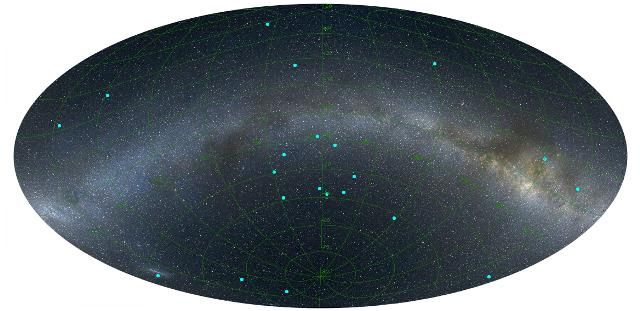
"An image of the distribution of GRBs on the sky at a distance of 7 billion light years, centred on the newly discovered ring. The positions of the GRBs are marked by blue dots and the Milky Way is indicated for reference, running from left to right across the image. Credit: L. Balazs."
Via the Royal Astronomical Society:
A Hungarian-US team of astronomers have found what appears to be the largest feature in the observable universe: a ring of nine gamma ray bursts—and hence galaxies—5 billion light years across. The scientists, led by Prof Lajos Balazs of Konkoly Observatory in Budapest, report their work in a paper in Monthly Notices of the Royal Astronomical Society.Oh no big deal. Just a discovery that could yield a radical revision of current theories of the evolution of the cosmos! Just another day's work.
Gamma-ray bursts (GRBs) are the most luminous events in the universe, releasing as much energy in a few seconds as the Sun does over its 10 billion year lifetime. They are thought to be the result of massive stars collapsing into black holes. Their huge luminosity helps astronomers to map out the location of distant galaxies, something the team exploited.
The GRBs that make up the newly discovered ring were observed using a variety of space- and ground-based observatories (the sample is listed in the Gamma Ray Burst Online Index). They appear to be at very similar distances from us—around 7 billion light years—in a circle 36° across on the sky, or more than 70 times the diameter of the Full Moon. This implies that the ring is more than 5 billion light years across, and according to Prof Balazs there is only a 1 in 20,000 probability of the GRBs being in this distribution by chance.
Most current models indicate that the structure of the cosmos is uniform on the largest scales. This 'Cosmological Principle' is backed up by observations of the early universe and its microwave background signature, seen by the WMAP and Planck satellites. Other recent results and this new discovery challenge the principle, which sets a theoretical limit of 1.2 billion light years for the largest structures. The newly discovered ring is almost five times as large.
...Prof Balazs comments: "If we are right, this structure contradicts the current models of the universe. It was a huge surprise to find something this big – and we still don’t quite understand how it came to exist at all."
The team now want to find out more about the ring, and establish whether the known processes for galaxy formation and large scale structure could have led to its creation, or if astronomers need to radically revise their theories of the evolution of the cosmos.




Shakesville is run as a safe space. First-time commenters: Please read Shakesville's Commenting Policy and Feminism 101 Section before commenting. We also do lots of in-thread moderation, so we ask that everyone read the entirety of any thread before commenting, to ensure compliance with any in-thread moderation. Thank you.
blog comments powered by Disqus